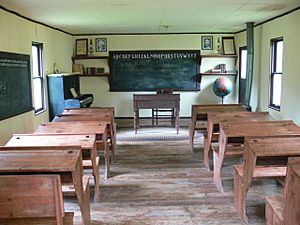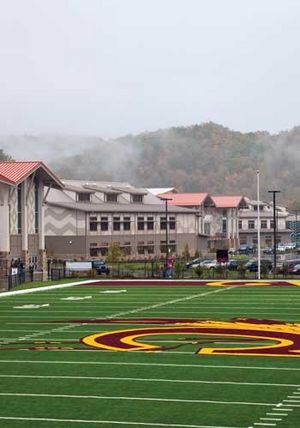Eastern Band of Cherokee Indians Educational Policies facts for kids
The Eastern Band of Cherokee Indians (EBCI) has a long history of shaping education for its people. When the EBCI decided to manage the schools on their land, known as the Qualla Boundary, it marked a big step in taking charge of their children's learning. This happened because of the Tribally Controlled Schools Act of 1987.
The EBCI Tribal Council has created many programs to help its members at every stage of their education. These programs, how they are paid for, and how they work with tribal members and others are always changing. This depends on the decisions made by the EBCI Tribal Council. While the Tribal Council doesn't directly set all education policies, some members serve on boards that guide schools. Also, the directors of educational programs report to the Tribal Council regularly. The goals, plans, and ways these EBCI education programs work show how they help the community.
Contents
A Look at Education History
The Cherokee people first started getting formal education around 1804 from missionary groups in northern Georgia. But during the forced removal of Cherokees to Oklahoma in 1838, education almost completely stopped. For the Cherokees who remained in Western North Carolina, the Quakers provided education through agreements until the late 1800s.
The Eastern Band of Cherokee Indians was officially recognized by the U.S. Congress in 1868. A few years before that, North Carolina also recognized them. In 1890, the Bureau of Indian Affairs (then called the U.S. Indian Service) set up boarding schools across Cherokee lands. These boarding schools became day schools in 1954. By 1962, these community day schools closed when a central elementary school opened.
EBCI schools first came under tribal control in 1990, after Congress passed the Tribally Controlled Schools Act of 1988. The U.S. Congress believed that "self-determination" (meaning a group's ability to govern itself) depends on education that helps people become good leaders. Since then, the EBCI has strongly supported education.
The EBCI Tribal Council has included funding for many tribal schools in the Cherokee Code (their official governing document). They have also worked hard to support many other educational efforts. The Tribal Council, along with the Cherokee Preservation Foundation, has helped independent schools like the Kituwah Preservation & Education Program (KPEP). KPEP's main goal is to bring back the Cherokee language. The EBCI also created the Higher Education and Training department to help EBCI students go to college and beyond.
Current Programs
Qualla Boundary Head Start
The Qualla Boundary Head Start (QBHS) includes Head Start and Early Head Start programs. These are located on the Qualla Boundary in Cherokee, North Carolina. Head Start is a federal program for preschool children from families with lower incomes. QBHS gets money from federal, state, and tribal sources. It is part of the Cherokee Tribal Child Care Services division.
The Cherokee Tribal Child Care Service division believes:
- Children have basic needs that should all be met.
- Children benefit most from a complete program that offers many services. The child's whole family and community must be involved.
- The program should build on each child's and family's strengths and unique culture. This helps children become capable and helpful members of society.
The QBHS/EHS program has 250 children. They attend at two locations: the Dora Reed Children's Center and the Big Cove center. Most of the children (87%) are enrolled members of the Eastern Band of Cherokee Indians. The Dora Reed Children's Center serves babies and toddlers through Head Start and Early Head Start. The Big Cove Center is only for Head Start children aged 3–5. The Early Head Start program also helps pregnant women and offers care at the center and at home.
The Early Head Start/Head Start Goals & Objectives are:
- To offer a program that helps all children enrolled at CTCCS grow physically, emotionally, and mentally.
- To keep a full program that provides services to children, families, and the Cherokee Community.
- To promote health and safety for children, families, and staff.
- To manage all program operations for CTCCs.
- To handle all money matters for CTCCS according to EBCI rules.
Natalie Case currently directs QBHS/EHS. A policy board made of parents and two Tribal Council members helps govern it. Besides meeting state rules and federal reviews each year, QBHS/EHS also reports its progress to the Tribal Council.
Kituwah Preservation and Education Program
The Kituwah Preservation & Education Program (KPEP) started in 2006. It focuses on programs where children learn completely in the Cherokee language from birth to fifth grade. It also creates cultural resources for everyone and offers language programs for adults to help the Cherokee language grow.
Section 16C-21 of the Cherokee Code explains how the Kituwah Language Immersion Fund works and how it gets money. A small part (0.60%) of the total money the EBCI Tribal Government gets from gaming (like casinos) is set aside for Kituwah. KPEP has also created the Kituwah Language Revitalization Initiative to further the language. This program aims to improve life for EBCI members by increasing their language skills and cultural knowledge. It does this by getting community support, creating language programs for everyone, and making Cherokee commonly heard and spoken again.
The total immersion language programs are the lifeblood of the Kituwah language initiative. —Renissa Walker, Manager of KPEP
Culture is the context. Language is the medium. Immersion is the method" Renissa Walker
Currently, there are two full immersion programs: early childhood education and elementary education. Five preschool classrooms teach 24 children aged two to five years old. In 2010, the New Kituwah Academy became independent from the Cherokee Central Schools. All students at the New Kituwah Academy are enrolled members of the EBCI. The school has a four-star license from the North Carolina Department of Child Development. Students learn the same subjects as those in other schools, but at the New Kituwah Academy, all teaching is in the Cherokee language. The elementary part of the academy follows North Carolina's standard curriculum. Teachers and fluent Cherokee speakers work together in each classroom. The academy also teaches English language arts at the end of each school day, so students can read and write well in both languages and do well on tests.
The Cherokee Preservation Foundation, which gives the most money to the schools, praised KPEP. They said, "The Cherokee Language Revitalization initiative of the EBCI is not only unique, it is exceptional. It is, so far, unlike other tribal efforts. We must recognize the people involved, who are all brilliant, brave, passionate, and dedicated. The results of this review can only make an already outstanding tribal effort even better."
Atse Kituwah (New Kituwah) Academy means "Where the fire is being rebuilt." In 2008, a new $7 million school was built in Cherokee to continue the success of the preschool immersion program. This modern school is now the center for language revitalization. Atse Kituwah houses both immersion programs and offers community spaces, adult language classes, and serves as a language and cultural campus for the EBCI.
Graham County Indian Education Program
The Graham County Indian Education Program is part of the Graham County School system. It receives funding from the Eastern Band of Cherokee Indians and Title VII. This program has been active since the 1970s. It works with the Graham County School system to improve education using methods that connect to Cherokee culture. It serves the school system and EBCI members in Snowbird, North Carolina, which is about 45 minutes from the Qualla Boundary.
The program helps about 200 students from pre-kindergarten through high school. It acts as a link between the community, school, tribal programs, and home to support children in reaching their goals. The GCIE program has a manager, three tutors, one Title VII tutor, a Cherokee History teacher, and two Cherokee Language teachers. They all work towards one vision:
That every American Indian student will graduate from a challenging and culturally relevant high school as a well-prepared lifelong learner globally competitive for work and postsecondary education.
The manager works with the Parent Committee (a group of parents and school representatives) to discuss issues, concerns, and ways to improve. The GCIE's goal is to "create an environment that offers educational experiences and cultural opportunities. These promote high expectations and responsibility for American Indian students' academic success, preparing them for a competitive world."
Cherokee Central School
Cherokee Central Schools (in Cherokee: ᏣᎳᎩ ᎫᎾᏕᎶᏆᏍᏗ ᏚᏓᏥᏍᎬᎢ) are located in Cherokee, North Carolina. They combine the Cherokee Elementary School (Kindergarten – 5th Grade), Cherokee Middle School (6th Grade – 8th Grade), and Cherokee High School (9th Grade-12th Grade). In 2009, the central schools opened their new campus on the Ravensford land, which was recently returned to the tribe, in the Big Cove community.
The Eastern Band of Cherokee Indians operates the Cherokee Central Schools under the Tribally Controlled Schools Act of 1988. Section 16C-18 of the Cherokee Code sets aside 2.00% of the total money the EBCI Tribal Government gets from gaming to help fund the Cherokee Central Schools. The Cherokee School Board is responsible for creating the school system's rules and procedures.
The Cherokee School Board has elected members from the six nearby communities: Big Cove, Wolf Town, Paint Town, Bird Town, Yellow Hill, and Big Y. The board makes sure that all rules and procedures are followed. They also approve the school budget and ensure that all federal, state, and Southern Association of Colleges and Schools (SACS) accreditation standards are met. A representative from the EBCI Tribal Council also serves on the board to connect the two groups. The goal of the Cherokee Central Schools is to:
Empower Our Students, Preserve Our Nation, and Ensure Our Future.
Higher Education and Training
The Higher Education and Training Department is part of the EBCI's Community Education & Recreation Services Division. Section 16C-16 of the Cherokee Code explains how the Higher Education and Training Department is set up and funded. The Cherokee Code allows this department to receive 2.40% of the total gaming money the EBCI Tribal Government gets from Harrah's Cherokee Casino. The Cherokee Code also states what these funds should be used for by the Higher Education Department. It provides for education, such as classes needed to get into college, as well as classes at college, graduate, and professional schools. The mission statement of the Higher Education Department says:
The Education Program will give highest priority to all enrolled members of the Eastern Band of Cherokee Indians with access to financial assistance in his/her pursuits of a post-secondary education for future economic prosperity.



